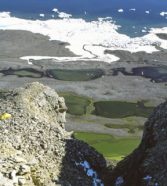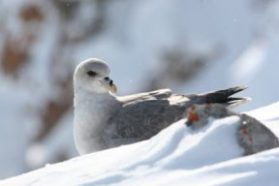Seabirds deliver Arctic pollutants
When birds look for food at sea, they pick up and carry pollutants back to their nesting areas.
By Emily Sohn
Birds are famous for carrying things from place to place. Some, like homing pigeons, can be trained to deliver messages and packages. Other birds unknowingly carry pollen, burrs, and seeds that latch on for the ride.
Canadian scientists have found a worrisome, new example of the power that birds have to spread stuff around. Way up north in the Canadian Arctic, seabirds are picking up dangerous chemicals in the ocean and delivering them to ponds near where the birds live.
 |
|
The high cliffs of Devon Island in the Canadian Arctic house seabirds known as northern fulmars. Droppings from these birds fertilize the green ponds below the cliffs and dose the ponds with mercury, pesticides, and other pollutants.
|
| Image courtesy of Mark Mallory. |
Some 10,000 pairs of the birds, called northern fulmars, make their nests on Devon Island, which is 640 kilometers (400 miles) north of the Arctic Circle. The fulmars travel as far as 400 kilometers (250 miles) over the sea to find food. When they return home, their droppings end up all around their nesting sites, including in nearby ponds.
Previously, scientists have noticed pollutants arriving in the Arctic with the wind. Salmon also carry dangerous chemicals, such as polychlorinated biphenyls (PCBs), as the fish migrate between rivers and the sea. The bodies of fish, people, and other meat-eaters can build up high levels of the chemicals.
 |
|
A northern fulmar.
|
| Image courtesy of Mark Mallory. |
To test the polluting power of northern fulmars, researchers from the University of Ottawa in Ontario collected sediment from 11 ponds on Devon Island. In ponds closest to the colony, the results showed that there was 10 times more of the pesticide hexachlorobenzene, 25 times more mercury, and 60 times more DDT than in ponds less affected by the birds.
The pollutants in the ponds, the study suggested, appear to come from fish that the birds eat when they’re out on the ocean.
People who live, hunt, or fish near bird colonies like those on Devon Island need to be careful, the researchers say. The birds don’t mean to cause harm, but the chemicals they carry can cause major problems.—E. Sohn
Going Deeper:
Milius, Susan. 2005. Arctic foulers: Foraging seabirds carry contaminants home. Science News 168(July 16):36-37. Available at http://www.sciencenews.org/articles/20050716/fob5.asp .
You can learn more about the northern fulmar at www.mbr-pwrc.usgs.gov/Infocenter/i0860id.html (U.S. Geological Survey) and collections.ic.gc.ca/arctic/species/northful.htm (Government of Canada).







